|
ICE Case Studies
|
Conflict in the Atacama By: Jacqueline Carpenter |
I.
Case Background |
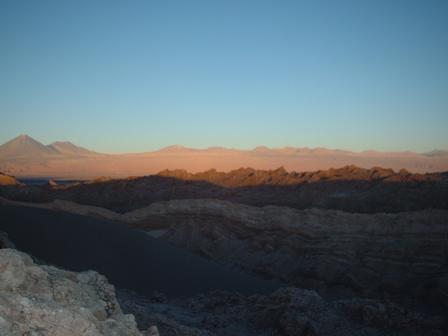
![]()
 I. CASE
BACKGROUND
I. CASE
BACKGROUND
1. Abstract
Throughout the 1800's Bolivia and Chile disagreed over which nation rightfully controlled the northernmost portion of the Atacama dessert. In 1879 the War of the Pacific (1879-1884) was brought about by a dispute between Bolivia and Chile over control of a portion of the Atacama Desert containing highly valuable mineral resources. The resources were exploited by Chilean and British companies who made great profits off of their export. When Bolivia decided to impose a tax on the export of these resources the conflict quickly escalated into war (once money became involved), despite the fact that the tax was enacted to fund the reconstruction of the port of Antofogasta which was highly used by Chile. Chile alleged that because of certain border treaties between Bolivia and Chile, Bolivia did not have the right to impose this export tax. Well-established in the extraction of nitrate resources from the region, in addition to its relative stability in comparison to Peru and Bolivia, Chile had a clear advantage going into the War of the Pacific. Additionally, Chile claimed that its territory had had always included the region being disputed, encompassing the entirety of the Atacama dessert. Ultimately, Chile emerged as the victor in the war, depriving Peru of much-desired resources and territory and Bolivia of its own access to the Pacific Ocean. The outcome of the war had a lasting impact, economically and even politically, in all three nations. In particular, Bolivia has suffered seemingly without end due to its lack of access to an ocean from which it can export its abundance of natural resources.
2. Description
The Region:
The Atacama desert is one of the driest locations on the planet, averaging less than half an inch of rain each year, often with numerous years passing without the area seeing a mere drop of rain. Just off the coast, the immensely cold waters of the Pacific Ocean house numerous schools of fish that have for centuries attracted "hundreds of thousands of sea birds, pelicans, cormorants, gulls, and others, who have hunted these waters for thousands and tens of thousands of years"(Farcau, 7). The birds feed on the residents of the ocean but reside themselves over the neighboring land. Due to the fact that the area was a desert, it naturally discouraged settlement by humans, allowing the birds and their byproducts (known as guano) were able to amass in this region of the South American continent. Over the years, deposits of guano many meters thick formed on the surface of the Atacama in the region. In addition to the guano, the Atacama region received deposits of minerals coming from water resulting from snow melting off of the western face of the Andes at the end of each winter. Due to the immense strength of the sun, this water, which formed into shallow pools, eventually dried up. As the waters dried they would leave behind deposits of minerals, called caliche.
Development of the Nitrate Export Industry:
In 1840, French scientist Alexander Cochet discovered that valuable quantities of sodium nitrate could be derived from both the guano and caliche found in the region. This discovery of their use as fertilizer and as a key ingredient in explosives, due to the high concentrations of nitrogen and phosphorous) made the area strategically valuable. Bolivia, Chile and Peru had suddenly found themselves sitting on the largest reserves of a resource that the world needed for economic and military expansion and Chile found itself in the position to be the one to extract that resource from its territory. After the discovery of the nitrate reserves, world powers were directly or indirectly vying for control of the area's resources. Nitrates were used as a form of fertilizer by many countries and were soon in high demand from the region due to a need in Europe to obtain greater productivity from a fixed amount of land available for agriculture. This lead to the rapid development of mining in the region, first of guano, merely because it was more readily accessible, and then of caliche. To capitalize on the profits to be made from guano and caliche, "foreign traders, especially the British, set up trading houses to ship guano back to England and Europe for trade and distribution, high in demand due to the European need to compete with larger-sized and more productive farms in the United States. "Americans, who also found guano to be valuable in increasing crop yields endeavored to help the U.S. government acquire islands in the Pacific and the Caribbean to ensure American reserves of these valuable resourcs (under the U.S. Guano Island Act of 1856)(Guano).
The physical extraction of both the guano and caliche led to an additional layer of environmental conflict. The conditions under which the workers were forced to live and work were deplorable. Needing to be close to the resources, the workers lived directly on top of the guano deposits. While working, "the digging and hauling activities raised permanent clouds of acrid dust that penetrated the eyes, the nose, the mouth, contaminated the water, and liberally garnished the poor food the men ate...and everything was overlaid with an appalling stench that could be detected for miles out to sea, an odor not just of hundreds of sweating bodies that would not be washed for weeks on end, but of rotting fish, salt, and excrement from which there was no escape" (Farcau, 9). There workers were paid appallingly low wages, which, when added to the horrid working conditions, left the extraction companies with great difficulty in finding labor, despite the relative ease of the job itself.
All of a Sudden Everyone Wants Bird Droppings... (and caliche)
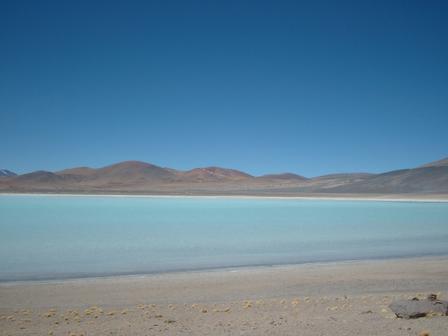
Bolivia,
Chile and Peru were all conducting some nitrate extraction the territory.
Due to Peru's focus on other interests within its borders and a lack of Bolivian
interest in doing the extraction, most economic exploitation of the coastal
region done by Chilean and British companies, largely with the justification
that Chile was more capable of handling the job because of its more robust
economy and stable institutions. As the economic situation of all three
countries continued to worsen, conflict
erupted over control of the territory and over the financial benefits to be seen from
having that control. After an initial attack levied by Chile, the war continued
for five years. The War of the Pacific was ended by the signing of the Treaty of
Anacin as well as truce between Bolivia and Chile, however, true peace and
agreement between the three nations was not reached until many years later (Farcau,
191).
In winning the War of the Pacific, Chile inherited "the world’s only commercially viable deposits of sodium nitrate, a natural source of nitrogen that was the world's leading fertilizer in the decades before World War I" (Sicotte). The export tax levied on firms exporting those nitrates accounted for approximately fifty percent of the Chilean government's total revenue.
3. Duration: 1879-1884
4. Location
Continent: South America
Region: Western South America
Country: Chile (Atacama Desert region, specifically between the 23rd and 26th parallels).
5. Actors: Chile, Bolivia and Peru
 Chile
Chile
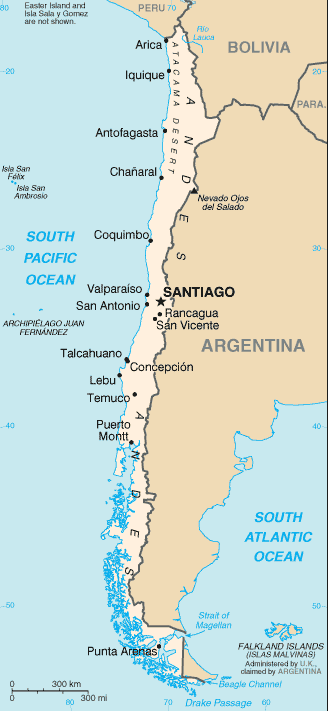 Although
Chile declared its independence in 1810, decisive victory over the Spanish was
not achieved until 1818. In the War of the Pacific (1879-84), Chile defeated
Peru and Bolivia and won its present northern lands, thereby extending its
territory, which contributed significantly to Chile's prominent position (in
comparison to its neighbors) seen today (CIA).
Unlike Peru and Bolivia , the Chilean population has a small indigenous portion,
which accounts for a mere three precent of the total population, where as the
percentages of the population are at least part indigenous in Bolivia and Peru are
eighty-five and eighty-two, respectively(CIA).
Additionally, though it was very much isolated from its neighbors, Chile was a
geographically cohesive nation. No segment of the country was ever more than a
weeks travel from the ocean, even in the nineteenth century, where as both
Bolivia and Peru were plagued by the size of their lands and the distance that
had to be traveled from many parts of their land to the ocean. In the late
nineteenth century Chile entered a period of economic downturn. Other nations,
such as the United States and Australia began to be stronger competitors for
Chilean exporters, mainly of wheat and beef (Farcau, 27).
Although
Chile declared its independence in 1810, decisive victory over the Spanish was
not achieved until 1818. In the War of the Pacific (1879-84), Chile defeated
Peru and Bolivia and won its present northern lands, thereby extending its
territory, which contributed significantly to Chile's prominent position (in
comparison to its neighbors) seen today (CIA).
Unlike Peru and Bolivia , the Chilean population has a small indigenous portion,
which accounts for a mere three precent of the total population, where as the
percentages of the population are at least part indigenous in Bolivia and Peru are
eighty-five and eighty-two, respectively(CIA).
Additionally, though it was very much isolated from its neighbors, Chile was a
geographically cohesive nation. No segment of the country was ever more than a
weeks travel from the ocean, even in the nineteenth century, where as both
Bolivia and Peru were plagued by the size of their lands and the distance that
had to be traveled from many parts of their land to the ocean. In the late
nineteenth century Chile entered a period of economic downturn. Other nations,
such as the United States and Australia began to be stronger competitors for
Chilean exporters, mainly of wheat and beef (Farcau, 27).
As Chilean exports declined, the country's foreign debt steadily increased, most notably doubling between 1860 and 1870 (Farcau, 27). As a consequence of these challenges, the Chilean government was eager to acquire the nitrates in the Atacama region. With its nitrate-export firms already working in the territory in question, Chile felt entitled to claim the territory. When Bolivia imposed a ten cent tax on each quintile (100lbs) of nitrates exported from the territory, Chile vehemently protested but Bolivia refused to retract the tax. Consequently, Chile decided to assert its position (by assembling an army and initiating the War of the Pacific).
The War itself was not fought just over this miniscule tax. According to the government of Chile, "Bolivian provocation threatened the Chilean communities who had created 'cities in the desert' and that the combination of Bolivia and Peru in a hostile alliance threatened Chile's sovereignty and territorial integrity, with the decision to war being taken in Santiago only after 'much agonizing'"(Farcau, 44). This argument, similar to that which was espoused by Peru regarding its involvement in the war, did not hold much merit since the country had arduously been trying to inch is border farther north for some time.
During the war Chile had taken to printing money in order to finance government operations. This left the government with more problems to deal with once the war had ended. After winning the war, Chile hoped that the income it would receive from the export of the nitrates would solve many of its economic woes. By increasing the tax levied on the export of nitrates, the government increased its income. By the time new Chilean elections came around, in 1885 half of the government’s revenue from the nitrate exports had been used to pay off European bondholders. The remaining half of the income was able to be spent on other programs the government wished to invest in. However, this economic windfall did not encourage the Chilean government to spend its money wisely. By 1900, Chile had earned close to three billion pesos from the export of nitrates. The triggered lavish spending on the part of the government for many years, though little investment was made into modernizing the state or looking for different sources of revenue (i.e. income taxes) in the event that the nitrate exports stopped being profitable. Not surprisingly, a century after the dependence of the government of nitrate exports for half of its income began, scientific discovery found a way to produce the ammonia needed for fertilizer and caused the demand for Chilean nitrate exports to dramatically dive. This left Chile to find different sources of income - a process that would take many years and cause the government great hardship in the meantime (Farcau, 197). This scenario, know in economics as the "Dutch Disease" is not uncommon. Often times, when countries seen an increase in demand for a natural resource they will not invest in the development of other industries, leaving the country with a weakened economy when demand for the natural resource declines. In the case of the nitrates, that is exactly what Chile's government did. When nitrates could be replaced with a synthetic substitute, demand for nitrate resources from Chile dramatically declined. While there is still some nitrate mining taking place in Chile today, the country is more dependent on its copper mining industry and devotes substantial time and energy to the development of that industry. If global deman for copper falls, Chile risks putting itself in a similar predicament, whereby it will have to scramble for ways to increase its trade to make up for losses in the mining industry.
 Bolivia
Bolivia
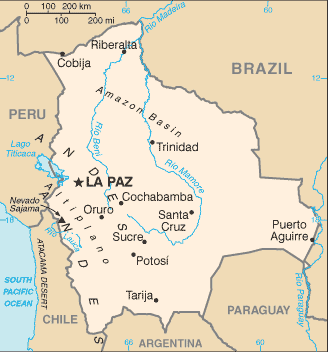 Bolivia
became an independent nation in 1825. By 1875 Bolivia found itself in a dire
economic situation, said to neither produce nor consume, despite its abundance
of resources and relatively large population (relatively) at the time. The vast
majority of the Bolivian population at the time was composed of indigenous
peoples, with eighty percent of the population unable to speak Spanish (Farcau,
21). Most income that Bolivia did generate came from mining. However, when
the guano and caliche deposits were discovered, despite its functional expertise
in mining, Bolivia was unable to reap the benefits of the newly-discovered
resources because the attention of the current mining infrastructure was wholly
consumed by existing mining projects (not unlike
today), with no ability to divert attention to the nitrate deposits
(Farcau). Consequently, Chilean
companies were able to move into the territory and extract the nitrate
resources.
Bolivia
became an independent nation in 1825. By 1875 Bolivia found itself in a dire
economic situation, said to neither produce nor consume, despite its abundance
of resources and relatively large population (relatively) at the time. The vast
majority of the Bolivian population at the time was composed of indigenous
peoples, with eighty percent of the population unable to speak Spanish (Farcau,
21). Most income that Bolivia did generate came from mining. However, when
the guano and caliche deposits were discovered, despite its functional expertise
in mining, Bolivia was unable to reap the benefits of the newly-discovered
resources because the attention of the current mining infrastructure was wholly
consumed by existing mining projects (not unlike
today), with no ability to divert attention to the nitrate deposits
(Farcau). Consequently, Chilean
companies were able to move into the territory and extract the nitrate
resources.
Bolivia 's long history of political instability, with over 200 coups on its record, has left the country plagued by weak political institutions (not unlike many other developing nations). The country's diverse ethnic populations and highly active indigenous groups serve to bring about even greater polarization of politics and government. In 2003, violent political protests (led by left-wing leader Evo Morales) broke out in the country's capital over the prospect of increasing taxes, budget cuts and further marginalization of the most downtrodden people in Bolivian society, forcing then-President Gonzalo Sanchez de Losada to resign, despite the best political manipulations of James Carville and his top political consultants (Our Brand is Crisis). In December 2005, Bolivians elected Movement Toward Socialism party leader Evo Morales to the presidency by the widest margin of any presidential candidate since 1982 (when civilian rule was restored to the nation). Morales' promise to change the country's traditional political class and empower the nation's poor majority appealed to marginalized persons in Bolivian society as well as working class citizens hoping for a better economic situation.
 Peru
Peru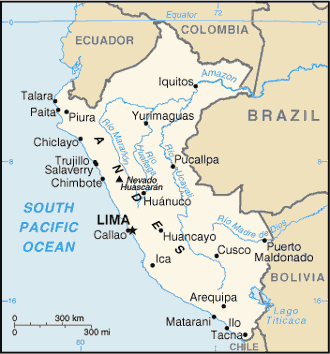
The territory now known as Peru was first inhabited by Spain in 1533. Peruvian independence was declared in 1821 and any Spanish forces that remained in the territory were defeated in 1824. While Peru emerged from the wars of independence as the most powerful nation in South America, in no small part due to its abundance of natural resources such as silver, copper, sugar, guano and other nitrates, by the final quarter of the 19th century the country was facing a steady decline. The vast territory of Peru is broken up by mountains, leaving various disconnected parcels of land, some rich with nutrients and arable while others were nearly inaccessible at the time due to mountains or heavy rainforest.
The discovery of the guano deposits at first gave the Peruvian government hope that its financial problems and debt would be alleviated. However the actions of multiple governments, in regard to the nitrate deposits, resulted in worsening the country's economic situation. Instead of taking advantage of the resources to benefit the country by opening the industry to new domestic companies, the government instead gave contracts to foreign firms which resulted in the firms garnering significant profits while the Peruvian government gained little in financial means, receiving only 1/3 of the sale price of the guano (Farcau, 14).
Peru had many motives for participating in the War of the Pacific. In the first place, the prospect of losing territory that contained guano, in the eyes of the government, would have served to worsen the country's already grim situation. Additionally, the outcome of a brief war with Spain convinced Peru that there was great need to have control of the coastline along the area of the Atacama containing the guano deposits. Those factors, combined with an obligation to honor the mutual defense treaty it had with Bolivia, provided the country with a great impetus for fighting in the War of the Pacific. Additionally, and for rational reasons, Peru became involved with the war for fear that a victorious Chile would come after additional Peruvian territory and out of fear of the possibility that Peru and Bolivia could become allies and combine forces against Peru.
![]()
 II. Environment
Aspects
II. Environment
Aspects
6. Type of Environmental Problem: Resource, Rights, Access to Minerals, Access to Water
The environmental problem at issue in this case was a conflict over control of the Atacama Desert, the region of land lying in the northeastern-most corner of Chile, abutting Bolivia and Peru. Resource issues were the primary reason for the dispute, since both countries sought the territory for control over its natural resources (nitrates) and its use as a route to the Pacific Ocean, in the case of Bolivia. Sodium nitrate was a key fertilizer until the First World War. The dry climate of the Atacama region served as an excellent catalyst for the breeding of sodium nitrate. In fact, this region was the only location where sodium nitrate was produced and exported, primarily to Europe and the United States. An additional environmental problem was the human health issues created by the nature of the work involved with extracting the nitrates in their original form (guano and caliche) in order to obtain the sodium nitrate. Workers had no choice but to live atop the guano and breathe the substance into the lungs and ingest its dusk on their food on a continual basis.
7. Type of Habitat: Dry
The land in this region is flat. The Atacama is the driest desert in the world.
8. Act and Harm Sites:
Act Sites: Bolivian and Peruvian territory and Pacific Ocean along coastline.
Harm Sites: Bolivian and Peruvian territory.
![]()
 III. Conflict
Aspects
III. Conflict
Aspects
9. Type of Conflict: War
The War of the Pacific was an interstate war.
10. Level of Conflict: Interstate
Violent conflict between Chile and Bolivia began on March 1, 1879, with Chile initiating the War against Bolivia, and Peru who was obligated to support Bolivia in any conflict because of military agreements between the two countries. Chile initiated the violence in response to Bolivia's insistence on levying a tax on nitrate exports which Chile felt to be a violation of border agreements between the two nations. The conflict lasted until 1884.
11. Fatality Level of Dispute (military and civilian fatalities): 1 - Low
The five-year conflict resulted in 14,000 deaths Correlates of War.
![]()
 IV. Environment
and Conflict Overlap
IV. Environment
and Conflict Overlap
12. Environment-Conflict Link and Dynamics: Direct
Although Peru, Chile and Bolivia all contained nitrates, the abundance of available nitrate resources in the Atacama region and the potential income to be earned from their export made conflict over the territory inevitable. With all three countries involved facing significant financial struggles, the incentive to control the territory and its resources was great.
Causal Diagram:

13. Level of Strategic Interest: Bi-lateral
The level of strategic interest was interstate and international. The governments of all three countries involved had a strategic interest in the outcome of the conflict, as did the multinational corporations that would be exporting nitrates from the region.
14. Outcome of Dispute: Victory
In the War of the Pacific, control of the waters was essential. In 1879 Chile obtained control of the port of Antofogasta, which allowed the superor Chilen navy to win multiple sea battles against Peru and Bolivia. After numerous land battles, Chile occupied Peru. The Chilean occupation lasted until 1884 when the Treaty of Ancn was signed, ending the war. As a result of this treaty, Chile became the victor of the war and was able to control the territory and resources in question, as well as access to the Pacific Ocean on the part of Bolivia. Chile's victory in this specific war laid the foundation for the economic success Chile experienced for the decade to follow, in comparison to Peru and Bolivia.
Peru came out of the War of the Pacific with a weakened government and resentful of the Chilean victory the resultant Chilean occupation of Peruvian territory.
As a result of the war, Bolivia ended up a landlocked state, forced to rely upon its neighbors for access to the ocean. The issue of access to the see has remains a part of Bolivian current events and politics through the present day. For instance, from 1932 until 1935 Bolivia fought against Paraguay in the Chaco War, partially with hopes of gaining better access to the Paraguay and Pilcomayo rivers, which would provide a route to the Atlantic Ocean. In the 1970's and the post-1990's Bolivia made repeated attempts at negotiating with Chile to reclaim some of the land stretching through Chile's northernmost province in order to obtain its own access to the sea. However, these attempts proved to be futile and the feud between Chile and Bolivia continues to be strong.
Today, Bolivia's landlocked status has dire effects on its prospects for development and its export of natural gas. A proposal to export Bolivian gas through Chile rather than Peru was met with strong disproval in Bolivia, regardless of a potential cost savings of $600 million, even leading to extreme rioting and ultimately the resignation of Bolivia's president. Former Bolivian President Carlos Mesa made the decision "to push the maritime issue to the top of his diplomatic agenda" during his presidency, though to no avail (Sicotte). The lack of Chilean support for Bolivia's pleas served to heighten the animosity felt between many in Bolivia towards Chile, Bolivia's long-time rival.
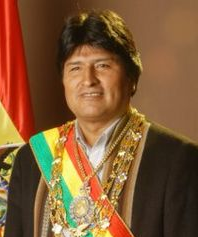 In recent Bolivian
elections, including the 2006 election, Bolivian presidential candidates have
undertaken strong campaigns to mobilize the anti-Chilean sentiment felt by the
Bolivian people. Often labeled a "narco-terrorist" for his support of Bolivian
coca growers, Bolivian President Evo Morales won his seat by winning over the
contingent of Bolivian society that feels exploited by the developed nations,
with his anti-business, anti-American attitude and refusal to work with the
United States. He played of off the feeling of exploitation held by the Bolivian
people, who are extremely hesitant to let control of their natural gas exports
fall into foreign hands. On May 1, 2006 President Morales announced his
intention to nationalize Bolivia 's natural gas resources (Bolivia's principal
export), is spite of vehement objections from the international community and
energy companies (Associated Press). The actions of Morales may serve to worsen
Bolivia socio-economic situation.
In recent Bolivian
elections, including the 2006 election, Bolivian presidential candidates have
undertaken strong campaigns to mobilize the anti-Chilean sentiment felt by the
Bolivian people. Often labeled a "narco-terrorist" for his support of Bolivian
coca growers, Bolivian President Evo Morales won his seat by winning over the
contingent of Bolivian society that feels exploited by the developed nations,
with his anti-business, anti-American attitude and refusal to work with the
United States. He played of off the feeling of exploitation held by the Bolivian
people, who are extremely hesitant to let control of their natural gas exports
fall into foreign hands. On May 1, 2006 President Morales announced his
intention to nationalize Bolivia 's natural gas resources (Bolivia's principal
export), is spite of vehement objections from the international community and
energy companies (Associated Press). The actions of Morales may serve to worsen
Bolivia socio-economic situation.
What is the significance of this?
It is not unrealistic to assume that Bolivia's current situation, as the poorest nation in all of Latin America, would be a lot less dire had Bolivia not lost its coastline to Chile. It is evident that the approaches to development that Bolivia has are not improving the welfare of the nation. The provisions made to landlocked states in the Law of the Sea, mainly a supposed guaranteed right to free transit to and from the sea, seem to have little effect on Bolivia's welfare. Additionally, Bolivia's repeated attempts to obtain direct access to the sea for itself are unquestionably made in vain. Chile is not willing to give Bolivia any portion or its territory, which Chile believes it won fairly and should not longer be in dispute.
In light of these facts, it would seem that in order for Bolivia to change its current state, the intervention of an outside party will be necessary. An international lawmaking organization, such as the United Nations (UN) will have to determine what should be done and intervene in the discussions held between Bolivia and its neighbors and ensure that Bolivia has a sufficient "dog in the fight." If the issue of Bolivia's access to the sea is to be resolved, an intervening party, like the U.N., must clearly identify the benefits for Bolivia and which ever country, be it Peru of Chile, will give Bolivia access to the sea. The settlement of this issue remains to be seen, but, if accomplished, could revolutionize the spirit of Bolivia. The successful resolution of this issue could bring great benefits, economic and political, to Bolivia and the nation that chooses to aid her.
![]()
 V. Related
Information and Sources
V. Related
Information and Sources
15. Related ICE and TED Cases
The historical case about guano and its impact on the trade and the environment is an interesting one. Guano, a natural fertilizer made from bird droppings, was a prized commodity during the 19th century and heavily traded by European and American traders. It helped build countries like Peru, expanded empires such as the United States, made companies and individuals involved rich, and exploited the local populations and the environment. Peru will be examined in detail because it was it's guano that was most valuable to foreign traders. Guano and the environment will also be reviewed at some length, as well as what other problems lay ahead for the guano-producing birds and their environment.
The Chaco War (1932-1935) was the result of a territory dispute between Bolivia and Paraguay. Both landlocked countries sought an expansion of territory in an effort to gain better access to the River Paraguay. This river runs through a stretch of territory between Bolivia and Paraguay known as the Chaco Boreal. In 1932, Bolivia attempted to break out of its landlocked situation and gain access to the Atlantic Ocean through capture of the River Paraguay; athwart that route lay the Chaco Boreal, which the Bolivians thought had large oil preserves. Paraguay, in a move instigated by national unity, heavily armed their borders and fought viciously to defend itself against Bolivia's advances. The resultant war was disastrous for both sides: Bolivia and Paraguay lost more than 100,000 soldiers. In 1935, Paraguay would eventually claim victory over Bolivia, thus firmly establishing the Chaco Boreal as a part of Paraguay.
As South America's poorest country, Bolivia is dependent upon exporting its natural resources abroad. The controversy over control of Bolivia's natural gas has been a key issue in Bolivia for many years. Indigenous portions of the population believe that the privitazation of Bolivia's natural gas only benefits the rich and the developed world. This case explores the cultural and political divide in Bolivia over this issue.
The Aozou Strip is a long stretch of desolate land located in the middle of the Sahara Desert. The area had been a zone of contention among the colonial powers of Africa, and remains so today between the now independent and sovereign countries of Chad and Libya. Rumors of rich uranium deposits compelled Libya to invade and capture the Aozou region from Chad in 1973. It remained in Libyan hands until a Chadian offensive in the late 1980s. In 1990, the two countries finally agreed to take their dispute to the International Court of Justice, which ruled in early 1994 that the Aozou Strip belonged to Chad.
In 1980 war erupted between Iran and Iraq. This war resulted in hundreds of thousands of casualties and a tremendous loss of oil revenues for both countries. The war eventually ended in 1988 but animosities have persisted. While the causes of the conflict were numerous and varied, one of the principals was access to, and control of, the Shatt-al-Arab waterway. Control of the waterway and its use as a border has been a source of contention between various states since The Peace Treaty of 1639. Ambiguities in this agreement (between the Persians and the Ottoman Empire) led to continual disputes that have not been resolved to this day. See maps of Iraq and Iran respectively below.
The Cordillera del Condor has been the site of armed disputes between the Peru and Ecuador for over one hundred and fifty years. Despite claims that the land is part of Ecuador, the area of confrontation is "recognized as Peruvian by the 1942 Rio Protocol, the 1945 arbitration decision, the 1947 U.S. Air Force aerial survey, and the documents issued after the 1981 border conflict."
How much is the Belizean rainforest worth? The Government of Belize values the rainforest at US $0.60 per acre, since it began selling logging rights at that price to foreign companies in 1993. The Mayan people of the Toledo district value the rainforest in a different way. Since 2,000 B.C., they have relied on the rainforest for their basic needs as well as spiritual value. This case study explores the clash between the Belizean government's need to attract foreign currency through meeting commercial interests of a Malaysian logging firm and the Mayan people's material and spiritual need to preserve the rainforest. These interests brought the parties into conflict.
There is more to the Falklands/Malvinas War of 1982 than meets the eye. It is abundantly clear that Argentina occupied the Islands, a British colony, to refocus attention from economical and social problems at the time. In short, it was a political maneuver by the Argentine government to escape its own state of social chaos. This case examines the history, motives, and consequences of oil exploration in this area from both the Argentine and British perspectives. By consequences I simply mean the environmental damages that oil exploration can have on any region.
The border between El Salvador and Honduras has been in dispute since the Spanish arrived in Central America. The Spanish divided the Central American territory into several viceroyalties whose borders have more or less remained since the sixteenth century. The border between Honduras and El Salvador, however, soon became disputed as El Salvador was one half the size of Honduras with almost double the population. Attempts to demarcate the border throughout the seventeenth, eighteenth and nineteenth centuries failed. On June 15, 1969, after a large influx of Salvadoran refugees in Honduras, the border dispute flared into a full-fledged battle between the two countries. After El Salvador defeated Honduras in a World Cup soccer match in San Salvador, national pride became the issue. After Honduran fans were chased from the stadium and watched the Salvadorans burn their flag, tempers peaked. Honduras protested the Salvadorans' actions; El Salvador accused Honduras of mistreating Salvadoran immigrants and refugees who had taken up residence in El Salvador. El Salvador broke off relations and moved into Honduras on July 15. The final demarcation of the border did not occur until 1992 when the World Court settled the issue.
The discovery of mineral deposits "at the sea-bed, or resting on it, as well as those in the subsoil beneath it" has flared intense debate concerning the equity, or inequity, of the distribution of the treasures of the earth. In retrieving deep sea-bed nodules, developed states have a distinct advantage over developing states in terms of technology and finance. Moreover, developing landlocked states, such as Bolivia, are placed in an even more precarious position due to the geographic disadvantage of having no outlet to the oceans directly under their jurisdiction. Consequently, these states, including Bolivia, have striven to ensure that they will not be prevented from sharing the bounties recovered from the earth. This goal has been sought primarily through a multilateral treaty under the auspices of the United Nations - the United Nations Convention on the Law of the Sea, or UNCLOS.
16. Relevant Websites and Literature
Barragan, Hugh Roberts. Gran Tracion en la Guerra del Pacifico. La Paz: 1979
Calvo, Roberto Querejazu. Alclaraciones Historicas sobre la Guerra del Pacifico. La Paz: 1995
Calvo, Roberto Querejazu. Guano, Salitre, y Sangre: Historia de la Guerra del Pacifico.
Farcau, Bruce W. The Ten Cents War. Praeger, London:1996.
"Lingering Feud with Chile Threatens Bolivia's Pipeline Plan," New York Times, July 8, 2002.
Sicotte, Richard, Catalina Vizcarra and Kristen Wandschneider. "Fertilizer, FIscal Crises and the War of the Pacific," April 2005.
Taylor, Robert. "Chile and Bolivia: 1879 War of the Pacific Redux?" World Press Review, March 2004, (VOL. 51, No. 3)
Our Brand is Crisis Directed by Rachel Boynton, 2005.
How to remake the image of a once unpopular president, who is now a candidate and how to market him and sell him to voters, is the basis of this excellent documentary. The idea of importing a team of American image consultants that have been notorious in the United States for their work in helping elect president Bill Clinton, not once, but twice, seems to be a novel idea for politics in South America. How will this team, headed by James Carville fare in helping to elect Gonzalo Sanchez de Lozada, a man who was an unpopular president in that country, seems to have made some sense to this candidate for his successful bid for a second term. After all, Mr. Sanchez de Lozada governed the country from 1993 to 1997, so why try to have the campaign run by Mr. Carville and his gang of experts?
Bolivia Bolivian history examined in detail.
Bolivia y su historia Information about the history of Bolivia and its people (in Spanish).
All maps and flags are courtesy of the
CIA
World Factbook.